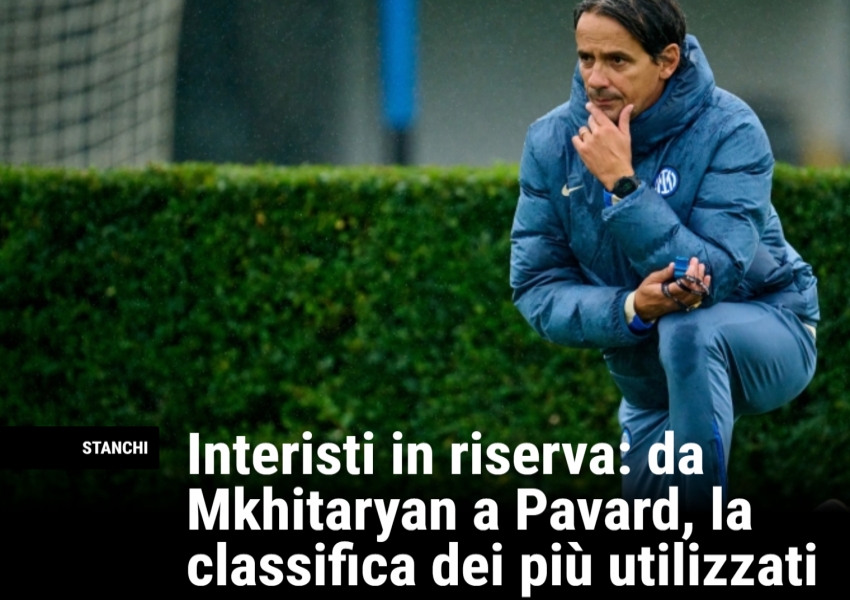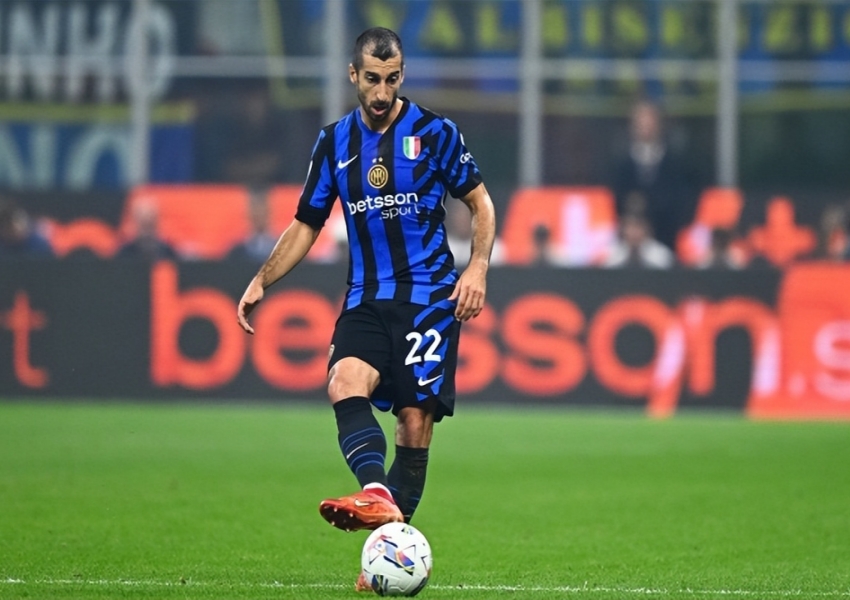Inter Milan’s “Workhorse Ranking” from Last Season to Present: Could the "11+4+7 Model" See Structural Changes?
As Inter Milan navigates the challenges of a new season, questions have arisen about the strain on certain key players and whether Simone Inzaghi’s reliance on a core group might limit the team’s sustainability. Recent analysis by Gazzetta dello Sport highlights the minutes logged by the club’s most used players since last season, raising concerns over fatigue and how it has impacted their performances in the 2023-24 campaign.

At the top of the minutes-played chart is goalkeeper Yann Sommer, who logged 3,900 minutes last season and has already accumulated 540 minutes this season. Close behind him is Henrikh Mkhitaryan with 3,526 minutes last season and 389 minutes this season, bringing his total to 3,915. Nicolò Barella follows with 3,502 minutes last season and 405 minutes this season, reaching 3,907 overall.

Other notable players include Marcus Thuram, who has played a combined 3,841 minutes, and team captain Lautaro Martínez, whose minutes total 3,800 across the two seasons. These figures illustrate how heavily Inzaghi has leaned on a small group of players, and the potential consequences of overusing them have become more apparent as the season progresses.

Fatigue and Form: A Mounting Concern
While the top spot on this list is occupied by Sommer—a goalkeeper whose physical toll is often lower due to the nature of his position—the outfield players, particularly Mkhitaryan, Barella, and Thuram, have shown signs of wear and tear. Mkhitaryan, often praised for his work rate and tactical versatility, has seen a noticeable dip in form. Despite starting the season strongly, his energy levels seem to be waning, which has affected his influence on games.
Barella, too, is dealing with injury issues, while Thuram, after an explosive start to the season, has seen a sharp decline in performance levels. Lautaro Martínez, one of the team's most consistent players last season, is currently in a goal-scoring slump, exacerbating the pressure on Inter's attacking unit.
The defense has not been spared either. Federico Dimarco has been plagued by minor injuries, forcing him in and out of the lineup, and Francesco Acerbi missed the European Championship over the summer due to fitness concerns. Benjamin Pavard, who joined the club recently, has also struggled with his form early in the season, adding to the concerns in the backline.
Gazzetta Criticizes Inzaghi's Squad Management
The Gazzetta has been critical of Simone Inzaghi's rotation policy, pointing out his reluctance to rotate key players more frequently. In the context of an expanded Champions League format and the demands of a packed domestic schedule, these concerns are not without merit. Last season, Inter operated with what Gazzetta called an “11+4+7 model,” where 11 players were mainstays in the starting lineup, four were used frequently as primary rotation options, and seven others saw significantly less action.
This top-heavy distribution of minutes led to a few players becoming indispensable to the team, with little rest to recuperate between fixtures. Inzaghi did make some strides in rotating his squad more effectively compared to the 2022-23 season, but the overall improvements remain modest. The Italian coach, who led Inter to their second star (20th Serie A title) last season, must continue to evolve in this area if Inter are to maintain their ambitions on multiple fronts.
Can the “4” Expand to “6 or 8”?
Commentator Altobelli has suggested a path forward for Inzaghi. Last season, Inter’s squad had 11 regular starters, and four players who were used frequently enough to be considered primary rotational options. These four were Carlos Augusto (2,349 minutes), Stefan de Vrij (2,168 minutes), Denzel Dumfries (1,959 minutes), and Davide Frattesi (1,580 minutes). After this group, a significant gap existed between them and the rest of the squad.
If Inzaghi can increase the number of primary rotation players from four to six or eight this season, it could dramatically improve Inter’s ability to manage fatigue across a longer, more demanding schedule. The signings of Mehdi Taremi and Piotr Zieliński, who have replaced aging squad players Alexis Sánchez and Davy Klaassen, are expected to help close the gap between starters and reserves. Taremi offers a more dynamic option in attack, while Zieliński’s ability to cover multiple midfield roles provides tactical flexibility.
Another player to watch is Yann Bisseck, who, despite being part of last season’s "7" group with just 1,100 minutes, has shown considerable growth. The German youngster has earned Inzaghi’s trust and is poised to challenge for more playing time this season.
The Youth Factor: Slow but Steady Growth for Asllani
One player whose development has been slower than expected is Kristjan Asllani. The Albanian midfielder was expected to take on a more significant role this season, but his progress has been gradual. At just 23 years old, Asllani still has time on his side. Several examples in Serie A history show that players in their early twenties often experience inconsistent form but undergo a breakthrough between the ages of 23 and 25. Marcelo Brozović is a prime example of this. After nearly leaving Inter for Valencia, Brozović returned a transformed player and became a key figure in the team’s midfield.
With time, Asllani could follow a similar trajectory, but for now, Inzaghi will need to rely on other midfield options while the Albanian continues his development.
Buchanan’s Comeback on the Horizon
Another intriguing subplot is the return of Tajon Buchanan. After recovering from a serious injury, the Canadian winger has been back in training for several weeks. He is expected to be fully fit after the next international break, providing Inzaghi with a potent attacking option off the bench. Inzaghi’s decision to include Buchanan in the Champions League squad, while leaving out Palacios and Joaquín Correa, indicates the coach has high hopes for the Canadian’s impact this season.
A Shifting Structure for Inter?
If Inzaghi can expand his group of primary rotation players from four to six or eight, as many analysts hope, it could significantly alleviate the pressure on the core 11 players. This would not only protect players like Mkhitaryan, Barella, and Lautaro from burnout but also ensure the team remains competitive across all competitions, including the Champions League.
Inter's 11+4+7 model worked last season, but if the "4" can be stretched to "6 or 8," the team could find greater balance and depth, especially as they contend with an even more congested fixture list this season.
It will be fascinating to revisit these numbers at the end of the season and see if Inzaghi’s squad management evolves as expected.
Copyright Statement:
Author: mrfootballer
Source: Mrfootballer
The copyright of this article belongs to the author. Reproduction is not allowed without permission.
Recommended Blog
- Manchester Giants Target Inter’s Key Assets: Inzaghi Wins Over Majority of United Fans
- Champions League Matchday 2: Arsenal's Defensive Woes Continue, AC Milan Solve Striker Problem
- From Last-Minute Heroes to Late-Game Victims: Is Inter Milan’s Squad to Blame?
- Standing Tall: Inter Survives Against Udinese's Aerial Threats as Young Star Steps Up
- Premier League Matchweek 6: Chelsea Find Their Stride, Manchester City Must Maximize Haaland
- Bundesliga Round 5: Dortmund’s Unexplained Slump and Stuttgart’s Formidable Forward Trio
- Bundesliga Round 4: Augsburg Shows Survival Expertise, Bayern’s New Coach Finally Gains Recognition
- Milan Derby Could Determine the Fate of Two AC Milan Coaches as Tensions Rise Between Ibrahimović and Fonseca
- UEFA Champions League Matchday One: Atalanta Fearless Against Premier League Teams, Barcelona the Biggest Title Contenders?
- Inter's Tactical Masterclass Against Manchester City: New Signings Shine as Guardiola Praises Their Defensive and Transition Game
Hot Blog
- Champions League Quarterfinals Set: Arsenal Crush PSV 9-3, Villa Dominate Brugge 6-1! Real Madrid vs. Arsenal Confirmed
- Champions League Drama: Rare Penalty Violation! VAR’s Eagle Eye Turns 60,000 Cheers to Silence
- Vinícius Jr. Misses Crucial Penalty as Atlético Fans Erupt – Bellingham Offers Consolation in Madrid Derby Thriller
- Champions League Quarterfinals Set to Take Shape – Arsenal and Villa Poised to Advance, Real Madrid in Strong Position, Dortmund Facing an Uphill Battle
- Real Madrid Survive Atlético Thriller: Win 4-2 on Penalties to Set Up Quarterfinal Clash with Arsenal
- 1-4! 0-4! A Dark 24 Hours for Chinese Football – Shanghai’s Giants Humiliated and Eliminated from the AFC Champions League
- 4 AM Showdown: Manchester United’s Do-or-Die Battle – Defeat Means Elimination and a Trophyless Season
- Man City’s 21-Year-Old Star Returns Home as a Hero! Receives $350,000 Mercedes, Gifts It to His Father
- AFC Champions League Quarterfinal Draw: Yokohama Faces CR7! Two High-Stakes Clashes as Japan’s Duo Battle in the Bottom Half
- Barça Unleashed: 26-Minute, 4-Goal Comeback Stuns Atlético as Flick’s Masterclass Makes History